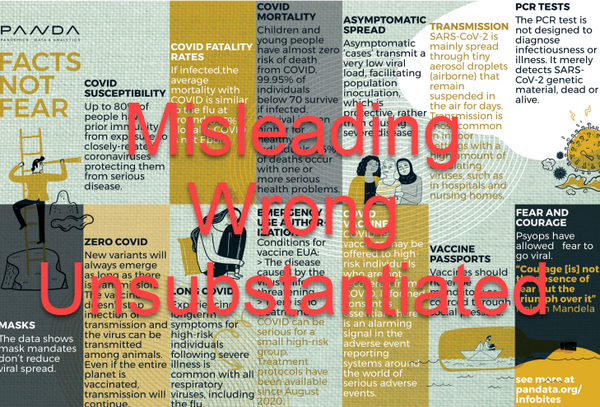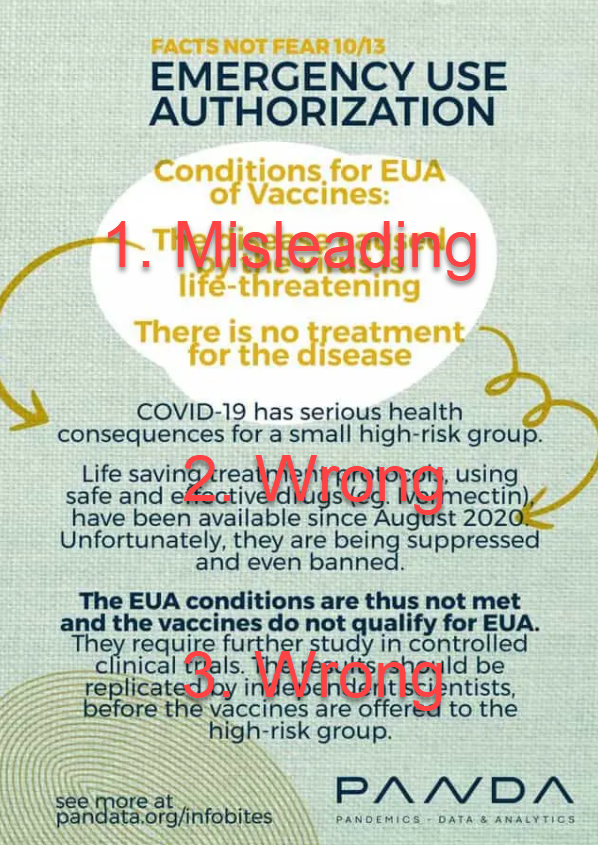Falsehoods not Facts: COVID-19 Susceptibility
Recently Pandemic Data Analysis (PANDA) has started spreading "infobites" under the heading "Facts Not Fear".
Here I address these and show how they are misrepresenting facts.
Lets start with 1/13:

The image does not provide references to these claims, but at least their website has a bit more details about what they are referring to.
Claim 1
For the first claim they refer to to work done by Imperial College of London Researchers in March 2020 and later published in Science.
Now we all know there are issues with modelling and we cannot accurately predict the course of the pandemic but what the researchers say is this:
We estimate that in the absence of interventions, COVID-19 would have resulted in 7.0 billion infections and 40 million deaths globally this year.
Note the bit I made bold: "in the absence of interventions". The modelling done is assuming we don't have interventions (e.g. lockdowns, masks, social distancing etc.) and people continue behaving as is. Thus it is a somewhat theoretical model as even if no laws were past, it would seem likely that behaviour would change if lots of people start dying in various countries.
These models were also then "wrong" about the ultimate outcome because countries chose to implement measures to reduce the death toll.
But, if you look at the projections made in this report for South Africa under the "no mitigation" scenario they predicted 216,000 deaths. Excess deaths in South Africa now are at over 260,000. The researchers estimating excess deaths expect 85%-95% of these deaths to be due to COVID-19. So the model is actually correct for South Africa and, strangely we suspect the following prediction seems then somewhat prophetic.
Mitigation strategies focussing on shielding the elderly (60% reduction in social contacts) and slowing but not interrupting transmission (40% reduction in social contacts for wider population) could reduce this burden by half, saving 20 million lives, but we predict that even in this scenario, health systems in all countries will be quickly overwhelmed. This effect is likely to be most severe in lower income settings where capacity is lowest: our mitigated scenarios lead to peak demand for critical care beds in a typical low-income setting outstripping supply by a factor of 25, in contrast to a typical high-income setting where this factor is 7. As a result, we anticipate that the true burden in low income settings pursuing mitigation strategies could be substantially higher than reflected in these estimates.
These models were clearly not perfect, but they provided a useful framework for decision making as opposed the PANDA "models" predicting 10,000 deaths in South Africa with no assumptions or details.
The Economist also estimates that worldwide excess deaths during the pandemic are between 10m and 19m (as at 16 October 2021) with the pandemic still continuing perhaps given some credence to the 40m estimate too.
Claim 2
PANDA claims that:
Up to 80% of people have prior immunity from exposure to closely-related coronaviruses, protecting them from serious illness.
They reference this preprint (unreviewed paper) posted in April 2021. Given that the paper has since been published in Science we will refer to the published paper as opposed to the preprint. We'd suggest PANDA do the same.
First we need to define "immunity" because it doesn't technically mean what we think it means. I found this article to be useful in understanding a about how immunologists think about immunity. This paragraph explains:
Even the word immunity creates confusion. When immunologists use it, they simply mean that the immune system has responded to a pathogen—for example, by producing antibodies or mustering defensive cells. When everyone else uses the term, they mean (and hope) that they are protected from infection—that they are immune. But, annoyingly, an immune response doesn’t necessarily provide immunity in this colloquial sense. It all depends on how effective, numerous, and durable those antibodies and cells are.
The 80% quoted appears in the text of the paper and refers to the prevalence of T-cells that were reactive to a particular coronaviruses (pre-dating SARS-CoV-2)
The paper then concludes that:
Preexisting cross-reactive CD4+ T cells enhance immune responses in SARS-CoV-2 infection and BNT162b2 vaccination. Because these cells are greatly diminished in the elderly, our results suggest that their decrease may contribute to the increased susceptibility of this population to severe COVID-19. Preexisting cross-reactive immunity may be responsible for the unexpectedly rapid induction of protective immunity after primary SARS-CoV-2 immunization and the high rate of asymptomatic and mild COVID-19 disease courses.
In this context this says is that exposure to other coronaviruses would allow our immune system to respond quicker to infection from SARS-CoV-2 virus or indeed a vaccine. It may explain some of the milder/asymptomatic disease of COVID-19.
So technically PANDA is stating it correctly but immunity here doesn't mean not at risk of infection. It just means your system can respond to the disease quicker and may have less severe outcome.
The paper just explains the variation between individuals and makes not statement about the risk of COVID-19 to people in general.
Claim 3

PANDA claims:
In March 2020, the Diamond Princess ship data showed that only a small section of the population is at risk of serious illness from SARS-CoV-2.
The article referenced describes the outbreak on the Diamond Princess, one of the cruise ships that struggled with COVID-19 outbreak early in the pandemic. So the first point is that the information being used here dates from March 2020 and clearly our understanding of COVID-19 has moved on since then.
Nevertheless, the article shows that 5.9% of passengers and 1.9% of crew tested positive. This sounds low, but we should note the following:
- Passengers were older than the crew and the article notes that increasing percentage of people tested positive at older ages.
- The symptoms for the first known case started 22 January 2020.
- From 5 February 2020 passengers and crew were isolated in their cabins. The article notes that "on this date, all passengers were also isolated in their cabins and internal air re-circulation was stopped to reduce the possible risk of airborne transmission."
- The paper only considered confirmed cases up to 9 February 2020.
To use this as an example of how many people in a general population would be at risk is therefore clearly wrong. It would only be useful if you were able to confine the whole population of a country to their "cabins" and stop "air re-circulation". I.e. the ship went into full lockdown and stopped the spread of cases. So we cannot tell what proportion of the people onboard were susceptible. Even if we could it would seem unlikely that the experience on a cruise ship could be extrapolated to the population of South Africa for example.
Also it seems likely that not all cases were picked up by the researchers as more people could ultimately be infected.
Thus the study shows that lockdown on a ship worked. Somewhat contrary to the general claims being made by PANDA in other pieces.



